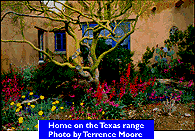
Just about everything’s big in Texas. But when it comes to water, well, there’s little to speak of. So how do some Texas homeowners reconcile their desire for vast green yards with a shortage of H2O? The answer is xeriscaping — a very big word indeed.
Derived from the Greek word xeros, meaning dry, xeriscaping is a form of landscaping that’s miserly with water. And while it may conjure up images of tumbleweed landscapes devoid of greenery save the occasional cactus, you can bet your 10-gallon hat that a xeriscaped yard can be as beautiful and lush as a Gauguin backdrop.
Xeriscaping fundamentals include using native and adaptive plants, creating efficient irrigation systems, improving soil quality, and mulching. In places like central Texas, where droughts are so bad you can get fined up to $2,000 for overwatering, residents who xeriscape may reduce the amount of water used for yard work by as much as 60 percent. And xeriscaped yards require less work overall — a big draw for those who have endured unbearably hot summers trying to revive a once-plush blanket of Kentucky bluegrass turned Cleveland brown.
“Mow grass and drag water hoses — that’s what I did all summer,” says Dal Watts, a retired electrician in Belton, Texas, recalling the upkeep needed for his old yard. Fed up with the hassle, Watts turned to xeriscaping 11 years ago. Today he grows wildflowers and buffalo grass, a native prairie grass that can be left to grow naturally (it reaches a maximum height of 6 to 8 inches) and is drought- and cold- tolerant. For Watts, it was a cure for the summertime blues: “I love it. There’s no watering and fertilizing. A couple times a year, I’ll mow. Other than that, I do nothing to take care of it.”
Today more than 40 states have xeriscape projects, and because xeriscapes are based on climate, there is great variation: An upstate New York yard teeming with bee balms, sunflowers, tulips, daffodils, grape hyacinths, snowdrops, and daylilies, for example, contrasts sharply with the irises, cornflowers, yarrows, California poppies, and catchflies that thrive in Reno, Nevada. Obviously, a place doesn’t have to be parched to benefit from xeriscaping. “Most North American landscapes are a disaster ecologically,” says Sally Wasowski, a landscape designer and co-author of Requiem for a Lawnmower. “The whole public has been trained to overwater and overfertilize.”
Finding what grows well in your yard is key to an effective xeriscape. One rule of the green thumb: Choose plants that are native to within a 50-mile radius of your home. Native plant societies, water districts, and university extension departments often keep such lists. Many cities also have xeriscape demonstration gardens.
Another trick to a successful xeriscape is grouping together plants with similar water needs. For instance, you wouldn’t put thirsty roses next to cacti — the water required for one would be wasted on the other (not to mention they’d have nothing to talk about). Xeriscaping also allows for an “oasis zone,” where gardeners grow a few prized water-guzzling plants. The oasis zone is often located in the front of a home where these plants can be easily watered and admired.
So, is this nation of nozzle junkies ready to dive into xeriscaping? “Most people aren’t going to take the plunge,” says Watts. “Perhaps if they would try a small section of the yard first, I feel 90 percent of them would be convinced.”
Sounds like it’s time to get our feet wet.
Other Hints For Greener Living:
To get kitchen appliances spick-and-span, fill an empty, clean spray bottle with 1/2 teaspoon of washing soda (sodium carbonate), 2 teaspoons of liquid soap, and 2 cups of hot tap water. Shake vigorously and go to it.
So, you’ve finally figured out how to set the time on the VCR? Forgettaboutit. The electricity Americans use to illuminate the clocks on such appliances as coffeemakers, microwaves, and stoves equals the total electricity used in Greece, Peru, and Vietnam combined. How’s that for time-consuming, eh? Unplug.
Source: Green Kitchen Handbook, by Annie Berthold-Bond and Mothers & Others for a Livable Planet (New York: HarperCollins, 1997).














